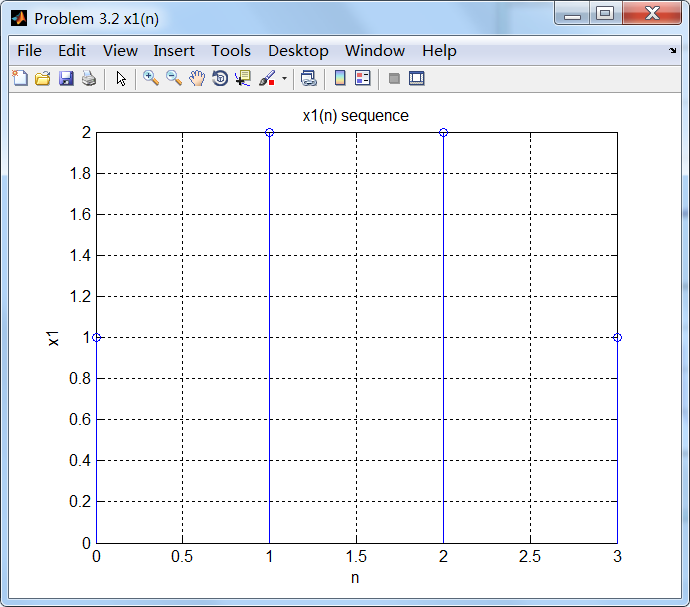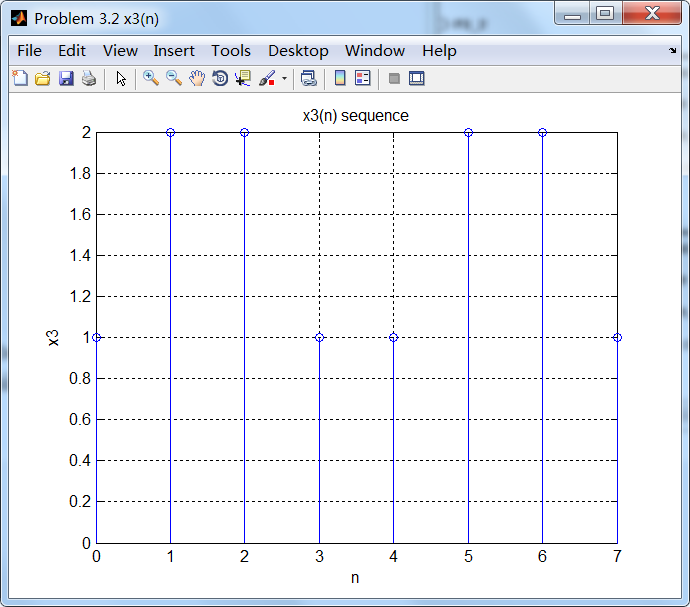
1、用x1序列的DTFT来表示x2序列的DTFT

2、代码:
%% ------------------------------------------------------------------------
%% Output Info about this m-file
fprintf('
***********************************************************
');
fprintf(' <DSP using MATLAB> Problem 3.2
');
banner();
%% ------------------------------------------------------------------------
% ----------------------------------
% x1(n)
% ----------------------------------
n1_start = 0; n1_end = 3;
n1 = [n1_start : n1_end];
x1 = [1, 2, 2, 1];
figure('NumberTitle', 'off', 'Name', 'Problem 3.2 x1(n)');
set(gcf,'Color','white');
stem(n1, x1);
xlabel('n'); ylabel('x1');
title('x1(n) sequence'); grid on;
M = 500;
k = [-M:M]; % [-pi, pi]
%k = [0:M]; % [0, pi]
w = (pi/M) * k;
[X1] = dtft(x1, n1, w);
magX1 = abs(X1); angX1 = angle(X1); realX1 = real(X1); imagX1 = imag(X1);
figure('NumberTitle', 'off', 'Name', 'Problem 3.2 DTFT of x1(n)');;
set(gcf,'Color','white');
subplot(2,1,1); plot(w/pi, magX1); grid on;
title('Magnitude Part');
xlabel('frequency in pi units'); ylabel('Magnitude');
subplot(2,1,2); plot(w/pi, angX1); grid on;
title('Angle Part');
xlabel('frequency in pi units'); ylabel('Radians');
X1_chk = (1+exp(-j*w*4)) .* X1;
magX1_chk = abs(X1_chk); angX1_chk = angle(X1_chk); realX1_chk = real(X1_chk); imagX1_chk = imag(X1_chk);
figure('NumberTitle', 'off', 'Name', 'Problem 3.2 X2(w) obtained by formular with X1(w)');;
set(gcf,'Color','white');
subplot(2,1,1); plot(w/pi, magX1_chk); grid on;
title('Magnitude Part');
xlabel('frequency in pi units'); ylabel('Magnitude');
subplot(2,1,2); plot(w/pi, angX1_chk); grid on;
title('Angle Part');
xlabel('frequency in pi units'); ylabel('Radians');
% -------------------------------------
% x2(n)
% -------------------------------------
[x2, n2] = sigshift(x1, n1, 4);
figure('NumberTitle', 'off', 'Name', 'Problem 3.2 x2(n)');
set(gcf,'Color','white');
stem(n2, x2);
xlabel('n'); ylabel('x2');
title('x2(n) sequence'); grid on;
M = 500;
k = [-M:M]; % [-pi, pi]
%k = [0:M]; % [0, pi]
w = (pi/M) * k;
[X2] = dtft(x2, n2, w);
magX2 = abs(X2); angX2 = angle(X2); realX2 = real(X2); imagX2 = imag(X2);
figure('NumberTitle', 'off', 'Name', 'Problem 3.2 DTFT of x2(n)');;
set(gcf,'Color','white');
subplot(2,1,1); plot(w/pi, magX2); grid on;
title('Magnitude Part');
xlabel('frequency in pi units'); ylabel('Magnitude');
subplot(2,1,2); plot(w/pi, angX2); grid on;
title('Angle Part');
xlabel('frequency in pi units'); ylabel('Radians');
% -------------------------------------
% x3(n)
% -------------------------------------
[x3, n3] = sigadd(x1, n1, x2, n2);
figure('NumberTitle', 'off', 'Name', 'Problem 3.2 x3(n)');
set(gcf,'Color','white');
stem(n3, x3);
xlabel('n'); ylabel('x3');
title('x3(n) sequence'); grid on;
M = 500;
k = [-M:M]; % [-pi, pi]
%k = [0:M]; % [0, pi]
w = (pi/M) * k;
[X3] = dtft(x3, n3, w);
magX3 = abs(X3); angX3 = angle(X3); realX3 = real(X3); imagX3 = imag(X3);
figure('NumberTitle', 'off', 'Name', 'Problem 3.2 DTFT of x3(n)');;
set(gcf,'Color','white');
subplot(2,1,1); plot(w/pi, magX3); grid on;
title('Magnitude Part');
xlabel('frequency in pi units'); ylabel('Magnitude');
subplot(2,1,2); plot(w/pi, angX3); grid on;
title('Angle Part');
xlabel('frequency in pi units'); ylabel('Radians');
运行结果:




通过第1小题得到的公式计算x2序列的谱,如下:

可看出,第1小题公式计算的结果,和直接将序列通过DTFT定义得到结果是相同的。